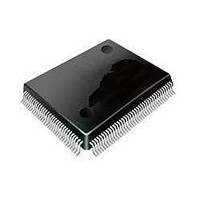ST92F120V1Q7 STMicroelectronics, ST92F120V1Q7 Datasheet - Page 267

ST92F120V1Q7
Manufacturer Part Number
ST92F120V1Q7
Description
Microcontrollers (MCU) Flash 128K SPI/I2C
Manufacturer
STMicroelectronics
Datasheet
1.ST92F120V9Q7.pdf
(325 pages)
Specifications of ST92F120V1Q7
Data Bus Width
8 bit, 16 bit
Program Memory Type
Flash
Program Memory Size
128 KB
Data Ram Size
4 KB
Interface Type
I2C, SPI
Maximum Clock Frequency
24 MHz
Number Of Programmable I/os
77
Number Of Timers
5
Maximum Operating Temperature
+ 105 C
Mounting Style
SMD/SMT
Package / Case
PQFP-100
Minimum Operating Temperature
- 40 C
On-chip Adc
8 bit, 16 Channel
Lead Free Status / Rohs Status
No
Available stocks
Company
Part Number
Manufacturer
Quantity
Price
Company:
Part Number:
ST92F120V1Q7
Manufacturer:
ST
Quantity:
6 765
Part Number:
ST92F120V1Q7
Manufacturer:
ST
Quantity:
20 000
Part Number:
ST92F120V1Q7C
Manufacturer:
ST
Quantity:
20 000
Company:
Part Number:
ST92F120V1Q7DTR
Manufacturer:
MAXIM
Quantity:
2 854
- Current page: 267 of 325
- Download datasheet (3Mb)
J1850 BYTE LEVEL PROTOCOL DECODER (Cont’d)
Bit 6 = JDIS Peripheral clock frozen .
When this bit is set by software, the peripheral is
stopped and the bus is not decoded anymore. A
reset of the bit restarts the internal state machines
as after a MCU reset. The JDIS bit is set on MCU
reset.
0: The peripheral clock is running
1: The peripheral clock is stopped
Note: When the JDIS bit is set, the STATUS reg-
ister, the ERROR register, the IMR register and
the TEOBP and REOBP bits of the PRLR register
are forced into their reset value.
Note: It is not possible to reset the JDIS bit and to
set the JE bit with the same instruction. The cor-
rect sequence is to first reset the JDIS bit and then
set the JE bit with another instruction.
Bit 5 = NFL No Frame Length Check
The NFL bit is used to enable/disable the J1850
requirement of 12 bytes maximum per frame limit.
The SAE J1850 standard states that a maximum
of 12 bytes (including CRCs and IFRs) can be on
the J1850 between a start of frame symbol (SOF)
and an end of frame symbol (EOF). If this condi-
tion is violated, then the JBLPD peripheral gets an
Invalid Frame Detect (IFD) and the sleep mode
ensues until a valid EOFM is detected. If the valid
frame check is disabled (NFL=1), then no limits
are imposed on the number of data bytes which
can be sent or received on the bus between an
SOF and an EOF. The default upon reset is for the
frame checking to be enabled.
The NFL bit is cleared on reset
0: Twelve bytes frame length check enabled
1: Twelve bytes frame length check disabled
J1850 Byte Level Protocol Decoder (JBLPD)
Bit 4:0 = JDLY[4:0] JBLPD Transceiver External
Loop Delay Selector.
These five bits are used to select the nominal ex-
ternal loop time delay which normally occurs when
the peripheral is connected and transmitting in a
J1850 bus system. The external loop delay is de-
fined as the time between when the VPWO is set
to a certain level to when the VPWI recognizes the
corresponding (inverted) edge on its input. Refer
to “Transmit Opcode Queuing” section and the
SAE-J1850 standard for information on how the
external loop delay is used in timing transmitted
symbols.
The allowed values are integer values between 0
µs and 31 µs.
JBLPD PHYSICAL ADDRESS REGISTER
(PADDR)
R246- Read/Write
Register Page: 23
Reset Value: xxxx xxxx (xxh)
The PADDR is an eight bit read/write register
which contains the physical address of the JBLPD
peripheral. During initialization the user program
will write the PADDR register with its physical ad-
dress. The Physical Address is used during in-
frame response types 1 and 2 to acknowledge the
receipt of a message. The JBLPD peripheral will
transmit the contents of the PADDR register for
type 1 or 2 IFRs as defined by the TXOP register.
This register is undefined on reset.
ADR7 ADR6 ADR5 ADR4 ADR3 ADR2
7
ADR1 ADR0
267/324
0
9
Related parts for ST92F120V1Q7
Image
Part Number
Description
Manufacturer
Datasheet
Request
R

Part Number:
Description:
8/16-bit Flash Mcu Family With Ram, Eeprom And J1850 Blpd
Manufacturer:
STMicroelectronics
Datasheet:

Part Number:
Description:
STMicroelectronics [RIPPLE-CARRY BINARY COUNTER/DIVIDERS]
Manufacturer:
STMicroelectronics
Datasheet:

Part Number:
Description:
STMicroelectronics [LIQUID-CRYSTAL DISPLAY DRIVERS]
Manufacturer:
STMicroelectronics
Datasheet:

Part Number:
Description:
BOARD EVAL FOR MEMS SENSORS
Manufacturer:
STMicroelectronics
Datasheet:

Part Number:
Description:
NPN TRANSISTOR POWER MODULE
Manufacturer:
STMicroelectronics
Datasheet:

Part Number:
Description:
TURBOSWITCH ULTRA-FAST HIGH VOLTAGE DIODE
Manufacturer:
STMicroelectronics
Datasheet:

Part Number:
Description:
Manufacturer:
STMicroelectronics
Datasheet:

Part Number:
Description:
DIODE / SCR MODULE
Manufacturer:
STMicroelectronics
Datasheet:

Part Number:
Description:
DIODE / SCR MODULE
Manufacturer:
STMicroelectronics
Datasheet:

Part Number:
Description:
Search -----> STE16N100
Manufacturer:
STMicroelectronics
Datasheet:

Part Number:
Description:
Search ---> STE53NA50
Manufacturer:
STMicroelectronics
Datasheet:

Part Number:
Description:
NPN Transistor Power Module
Manufacturer:
STMicroelectronics
Datasheet:











